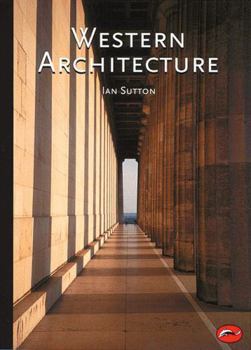Western Architecture: From Ancient Greece to the Present (World of Art)
(Part of the World of Art Series)
Select Format
Select Condition 
Book Overview
From the earliest classical temples to today's achievements, over two thousand years of Western architectural history are summarized. Every architectural style is the product of an ideology, and the author shows how the buildings of Greece and Rome, of the Early Christian and Byzantine centuries, of the Gothic Middle Ages, the Renaissance, and the Enlightenment grew out of their respective cultures. In the nineteenth century the story in Europe and North America became more complicated, with the competing forces of Romanticism and industrial functionalism leading to apparently contradictory results--a situation that continues today in the clash between postmodernism and high-tech. But perspectives change, and every decade has its own views of the past. Eastern Europe has inevitably been underrepresented in Western criticism since 1945; Czech Baroque, Polish Neoclassicism, and Hungarian Art Nouveau provide some unexpected revelations. Illustrated throughout with photographs closely linked to the text, this is a guide for the student and general reader to follow into the twenty-first century.
Format:Paperback
Language:English
ISBN:0500203164
ISBN13:9780500203163
Release Date:April 1999
Publisher:Thames & Hudson
Length:384 Pages
Weight:1.68 lbs.
Dimensions:0.9" x 5.9" x 8.3"
Customer Reviews
5 ratings
Great Book
Published by Thriftbooks.com User , 16 years ago
The book is very diverse and supplies a lot of pictures and diagrams to illustrate the points made in the text.
A Comparison of Three Popular Architectural Histories
Published by Thriftbooks.com User , 19 years ago
As an architectural novice who recently decided to learn more about it, I checked three books out of the library: The Story of Western Architecture, by Risebero; Western Architecture, by Sutton, and The Story of Architecture, by Glancey. This is a brief comparison of the three. Sutton: An attractive book with lots of coverage (I think more comprehensive than Risebero and certainly more than Glancey) and photos. The photos are black & white and unfortunately small due to the relatively small format of the (paperback edition) book. The text has a somewhat academic tone and concentrates on the buildings rather than the social theories expounded in Risebero's book. Risebero: An impressive book with many detailed line drawings but no photographs. The line drawings obviously lack the details and total impact of photos but they also allow the author to emphasize and isolate features of interest; photos can frequently confuse the eye with an excess of detail. Also includes sketches that illustrate building principles, e.g., what "pendentives" are, ways to intersect arches, etc. Risebero provides socio-cultural material that attempts to explain the reasons behind historical trends, movements, etc. I suspect this material is controversial among architectural historians, as such attempts usually are, but I lack the background to judge whether it exhibits strong biases, political agendas, etc. Glancey: A large-format book with beautiful color photographs. The only book of the three to include non-Western architecture, such as Africa, Asia, etc. The text is large-font and more simplistic in tone and content than the above two. Conclusions: Sutton was somewhat dry, lacking the feeling of continuity created by a narrative line. In contrast, Risebero's social commentary made for a better "story" (hence the title, I guess), but I did have the sense of social ideas being imposed upon me without having the background to evaluate them. Glancey's book was quite short and simple - perhaps almost more of a young-adult sort of book. If I were to pick a winner, it would be Risebero, for excellent line drawings and a storytelling feel that kept my interest. The only real lack was some nice big color photos (a la Glancey), but you can't have everything.
Easy to understand and a pleasure to read
Published by Thriftbooks.com User , 21 years ago
It's always best to have this subject explained by a single author, as opposed to several, each expounding on his or her specialized area, overwhelming the reader. On the other hand, if it's presented too briefly, it becomes an impossible-to-remember chronology of unrelated buildings. This book, though, presents it in just the right depth, using an effortless and light writing style. Greek temples, the author points out, show "no hint of a way to get in". Thus begins a story that, to paraphrase him, is complicated and impossible to simplify. Fortunately he explains it well: Romanesque is, in a way, the first Renaissance, as Charlemagne tries to associate his empire with Imperial Rome. The actual Renaissance is a transitional point because, for the first time, architecture is based on scholarship; this continues until the 19th century, as new archeological discoveries (early Doric columns had no bases) add to the repertoire. And he claims that a totally unknown Modern architect is on a par with Wright, showing he's confident enough in the subject to think for himself.
Lucid and readable
Published by Thriftbooks.com User , 22 years ago
With this book, Ian Sutton has struck gold. It is quite simply the best introduction to a fascinating subject, and a natural companion to David Watkins' "History of Western Architecture." In elegant prose Sutton charts the evolution of architecure from pre-classical Greece to the present day. Highly recommended for anyone interessed in the subject
Architecture of the Ages
Published by Thriftbooks.com User , 24 years ago
Western Architecture has many wonderful examples of old churches, catedrals and government buildings dating all the way back to the Roman Empire. Although this books has many great pictures, it spends very little time on domestic architecture and dosen't deal with many modern buildings.






